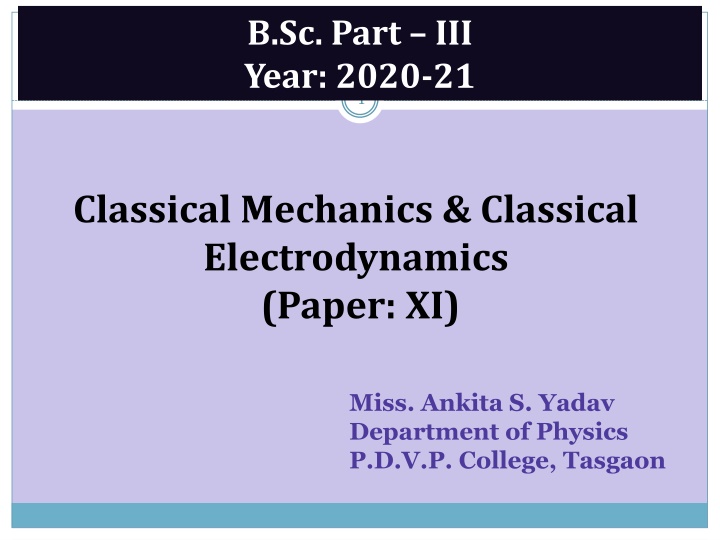
Classical Mechanics & Classical Electrodynamics in B.Sc Part III Year Syllabus
Explore the detailed syllabus of B.Sc Part III Year 2020-21 at P.D.V.P College, focusing on Classical Mechanics, Classical Electrodynamics, Mathematical Physics, Quantum Mechanics, and more. Dive into topics like Lagrangian Formulation, Techniques of Calculus of Variation, Special Theory of Relativity, and Charged Particles Dynamics.
Download Presentation

Please find below an Image/Link to download the presentation.
The content on the website is provided AS IS for your information and personal use only. It may not be sold, licensed, or shared on other websites without obtaining consent from the author. If you encounter any issues during the download, it is possible that the publisher has removed the file from their server.
You are allowed to download the files provided on this website for personal or commercial use, subject to the condition that they are used lawfully. All files are the property of their respective owners.
The content on the website is provided AS IS for your information and personal use only. It may not be sold, licensed, or shared on other websites without obtaining consent from the author.
E N D
Presentation Transcript
B.Sc. Part III Year: 2020-21 1 Classical Mechanics & Classical Electrodynamics (Paper: XI) Miss. Ankita S. Yadav Department of Physics P.D.V.P. College, Tasgaon
Shivaji University, Kolhapur: CBCS Syllabus Chemistry B.Sc. Part III Semester (V and VI) Nature of Syllabus 2 Semester V Paper XI : Mathematical Physics Paper X : Quantum Mechanics Paper XI : Classical Mechanics & Classical Electrodynamics Paper XII : Digital and Analog circuits and Instrumentation Semester VI Paper XIII : Nuclear and Particle Physics Paper XIV : Solid State Physics Paper XV : Atomic and Molecular Physics and Astrophysics Paper XVI : Energy Studies and Materials Science Theory: 200(50+50+50+50 =200 marks for each semester) Practical : 200
Unit I Chapter - 1 Lagrangian Formulation 3 Introduction Constraints Degrees of Freedom Generalised Coordinates Principle of virtual work D Alembert s Principle Application of Lagrange s Equation Solved Problems Questions; Problems
Chapter 2 Techniques of calculus of Variation 4 Introduction Hamilton s Principle Deduction of Hamilton's Principle from D Alembert s Principle Deduction of Lagrange s Equation from Hamilton s Principle Applications of the Techniques of the Calculus of variation Solved problems Question problems for practice
Unit II Chapter -1 Special Theory of Relativity 5 Introduction Inertial Frame of reference Non-inertial frame of Reference Galilean Morley experiments Postulates of special theory of Relativity Lorentz Transformation Equations Length Contraction Time Dilation Relativistic Addition of Velocities Variation of Mass with Velocity Mass energy Equivalence Relation Solved Problems ; Questions Problems for practice
Chapter 2 Charged particles Dynamics 6 Introduction Poisson s and Laplace s Equation Laplace s Equation in one dimension and its solution Motion of charged particle in Uniform Electric Field Motion of charged particle in Uniform Magnetic Field Motion of charged particle in crossed Uniform and Constant Electric and Magnetic fields Solved Problems; Questions Problems for practice
PHYSICS 7 Classical Mechanics Quantum Mechanics Atomic and Nuclear Mechanics Physics Thermodynamics Electrodynamics Optics
CLASSICAL MECHANICS 8 Definition: It is study of motion of body (macroscopic) under influence of forces Motions can be Translational Rotational Oscillating Circular
Basics of Classical Mechanics 9 Lagrange s (L) Atomic & Sub-atomic Mechanics CLASSICAL MECHANICS Coupled Oscillations Rigid Body Electricity and magnetism Hamilton s (H) D Almbert s
Constraints 11 The limitations or geometrical restrictions on the motion of particle or system of particles are known as constraints. The Constraints may be classified in the ways given below : First stage: a) Scleronomic b) Rheonomic Second stage: a) Holonomic b) Non- Holonomic Third stage: a) Conservative b) Dissipative
12 The force of ith particle is, According to Newton s second law of ith particle,
17 Thank You...
